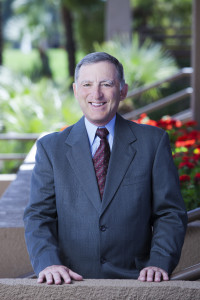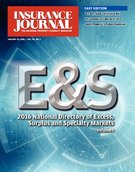Michael Miller, the longtime president and chief operating officer of Scottsdale Insurance Co., has stepped into a new executive role with corporate parent Nationwide where he’ll manage and spearhead strategic investments for the insurance giant.
Miller, now the new president of Nationwide Ventures, first joined Nationwide in 1985 and signed on with Scottsdale Insurance in 1995 as chief financial officer. He became Scottsdale’s president and COO in 2004. Under his leadership, Miller helped grow the excess and surplus lines insurer to a $3 billion company by 2014.
 In his new role with Nationwide Ventures, Miller will focus on investing in innovative companies, perhaps early stage or start-up companies, with the goal of providing longer-term benefits back into Nationwide, including its E&S operation.
In his new role with Nationwide Ventures, Miller will focus on investing in innovative companies, perhaps early stage or start-up companies, with the goal of providing longer-term benefits back into Nationwide, including its E&S operation.
Miller took some time in January to answer a few questions for Insurance Journal on his past experience in the excess and surplus lines (E&S) sector and the bright future in store for worthy competitors.
Insurance Journal: How would you characterize the E&S market in 2004 when you took over Scottsdale Insurance as president and COO?
Michael Miller: When I took over the leadership role at Scottsdale, the industry had gone through a strong growth period and was in what many would call, a hard market. My predecessor said that before he retired, he wanted one more hard market and he got it … and then retired. So the industry was in a growth mode that lasted for a few years but then the recession of 2007-2008 came along and changed the market for everyone. A few years of declining E&S premiums came about and we had to work our way through that time period.
One of the things that we did during those strong years was to prepare for when the tougher times came. We developed new opportunities, added new programs, worked on our internal and external processes and systems, all with the objective to be prepared for the tougher times. And we did very well during the downturn. We had one year of declining premium, a couple of years of flat premium and then began a growth cycle that resulted in Scottsdale hitting the $3 billion level in 2014.
How has the E&S market changed from that time in 2004 until today?
Miller: First of all, in 2004, technology was a competitive advantage and if you did not have good technology, you could make up for it in other ways. Today, that is not the case. Technology is the price of admission … you have to have it or it is very difficult to compete for business.
Also, in the people area, there is a transition of leadership occurring across the entire E&S industry. I have seen many of the key leaders that I was dealing with in 2004 move into retirement and the next generation is taking the lead roles. Not a bad thing but it is a change.
And lastly, I think the pace of change is accelerating. As you look across the United States and the world, you can see things coming that will dramatically change the way insurance companies handle risks and what risks we write. Take for example, driverless cars. It will happen and it will require the insurance mechanism to adjust to the new world of automobiles and driving. Cyber insurance is another category. As technology continues to advance, what kind of risks will come out of those changes and how does the E&S industry respond? It will not be business as usual.
Looking back is there anything you might have done differently or changed?
Miller: My time in the E&S industry and at Scottsdale were some really fun years. The people are great. The friends I have made will last a lifetime. The things I have been able to be involved in have been a challenge and enjoyable at the same time. I have been all over the United States and have seen the impact our industry has on the whole economic system in this country and around the world.
There are always things I would have done differently with 20/20 hindsight. One of the keys of being a leader is that you make decisions and you are willing to then admit it was not the right way to go and correct it. There are times that we should have moved quicker. Times we should have adjusted our approach sooner when results went south on a certain product.
Finally, focusing on the right technology is a key and that is a tough one to figure out. As soon as you start down a path, you are already out of date, technology wise.
What was the best stretch/cycle (years) for the E&S market?
Miller: I think the best stretch was in the mid ’80s. It was the hard market of 1984-1986 that propelled Scottsdale from a start up to a $500 million company in five years. There are legendary stories about the volume of business that was flowing into all companies and the challenges of getting it processed and on the books. It certainly would be the one time in this industry where anyone could write an account if they had the capital. I do not think we will ever see those kinds of conditions again.
What was the worst cycle?
Miller: The worst cycle followed the best cycle, ironically. From the early ’90s until the 9/11 attacks, we went through over 13 years of a soft market. While the economy did grow over that period of time, which provided additional risks to write, it was difficult to make the returns on capital and also to achieve any kind of rate increases. It was a long, dry spell for the E&S industry.
Throughout your career, how have brokers/brokerages changed?
Miller: I think the biggest change that has occurred with wholesale brokers over the past 15 years is consolidation. There are now several very large wholesale brokerage businesses that are the accumulation of several small- to medium-size organizations. The good news about the consolidation is that the same people were running many of the businesses before and after the consolidation. This meant that the talent levels of the wholesale operations were strong and they were then able to focus on new products, new technology and how to better serve their insurance clients.
Looking ahead, what influences do you see that might shape or alter E&S?
Miller: I think the E&S industry is very healthy today and will continue to be that way. It will challenge some as the market is flattening out on rates and competition is increasing so in order to be effective, you will have to be on your “A” game.
Also, I think there will be pressure to respond to the changing needs of the insureds. E&S has always been the responder to new areas and so I think that will be an important thing for the industry to continue to lead … product innovation. There will be a lot of new risks (or risks that are morphing into something different) that E&S needs to respond to.
And finally, I think talent will continue to be important to one’s success. As the boomers move out, companies have to be diligent in developing the next generation of leaders and other capabilities inside each organization.
Tell us about your new role at Nationwide Ventures. Will you continue to have a hand in E&S industry?
Miller: My new role is to lead a small group that will focus on investing in innovative companies and businesses. This would typically be early stage or start-up companies that have a new idea, concept, product or are developing some game-changing technology. Each of these investments will, over the longer term, provide some benefit back into Nationwide, including the E&S operation.
I will continue to consult with the Nationwide E&S team (formally Scottsdale Insurance). I will also be looking for things that will advance their cause and help them compete now and in the future. So I am not planning to lose my E&S ties.
The E&S industry has been described as a great place to be right now. Do you agree?
Miller: I do think the E&S industry is a great place to be. It has grown up over the past 25 years and is now an accepted part of the marketplace. Everyone recognizes the role E&S plays in insuring the difficult risks that could not get insurance anywhere else. And as things change, I think we will see more of these kinds of risks that will be looking to the E&S market for solutions.
E&S has always been the place where new products and capabilities were begun and operationalized. With the changes coming, I think this will provide a lot of opportunity for the E&S market to be responsive to the new generation of insurance needs. The companies that are progressive and are able to adjust to the changing times will thrive in this market. It will continue to be a competitive marketplace with more capital than needed and additional companies coming into the market. I have always valued competition because that is what keeps you from getting “fat, dumb and happy.” It forces you to be on your “A” game every day.
Finally, those that are good at what they do will find plenty of opportunities. … The future is very bright.
When you’re having a low-motivation day (do you have those?), what do you do to get yourself re-energized again?
Miller: That is a good question. I do not have low motivation days. But what does get my juices going is the opportunity to win the game. In this case, in leading E&S companies for the past 11 years, I always enjoyed the challenge of figuring out how to outperform others. How to adjust our company so that we could meet the needs of our producers? How to create a work environment that would cause our associates to love coming to work each day? How to impact our community through various nonprofit organizations? How to be involved in advancing the cause of helping others? All these are what I would call success factors. Put them together and I think you have a winning organization. And that gets me going quickly.
Topics Excess Surplus Tech Market
Was this article valuable?
Here are more articles you may enjoy.


 FBI Says Chinese Hackers Preparing to Attack US Infrastructure
FBI Says Chinese Hackers Preparing to Attack US Infrastructure  Vintage Ferrari Owners’ Favorite Mechanic Charged With Theft, Fraud
Vintage Ferrari Owners’ Favorite Mechanic Charged With Theft, Fraud  Grand Jury Indicts ‘Hole in Won’ Owner on Prize Insurance Fraud Charges
Grand Jury Indicts ‘Hole in Won’ Owner on Prize Insurance Fraud Charges  Harvard Study Again Stirs the Pot on Demotech Ratings of Florida Carriers
Harvard Study Again Stirs the Pot on Demotech Ratings of Florida Carriers 


